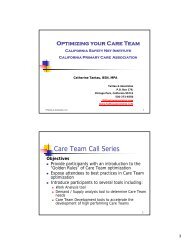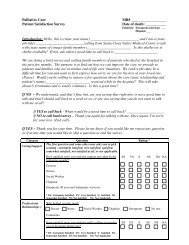Palliative Care Consult Service Overview and Case Examples
Palliative Care Consult Service Overview and Case Examples
Palliative Care Consult Service Overview and Case Examples
You also want an ePaper? Increase the reach of your titles
YUMPU automatically turns print PDFs into web optimized ePapers that Google loves.
<strong>Palliative</strong> <strong>Care</strong> <strong>Consult</strong> <strong>Service</strong><br />
<strong>Overview</strong> <strong>and</strong> <strong>Case</strong> <strong>Examples</strong><br />
Shoshana Helman, M.D.<br />
Medical Director, <strong>Palliative</strong> <strong>Care</strong><br />
Gary Lee, M.D.<br />
Associate Medical Director, <strong>Palliative</strong> <strong>Care</strong><br />
Santa Clara Valley Medical Center
What is <strong>Palliative</strong> <strong>Care</strong>?<br />
♦ Goals of palliative care<br />
Prevent <strong>and</strong> relieve suffering<br />
Support the best quality of life for patients <strong>and</strong> their families<br />
♦ Both a philosophy of care <strong>and</strong> a structured system<br />
♦ Exp<strong>and</strong>s traditional disease-model treatments<br />
Quality of life for patient <strong>and</strong> family<br />
Optimizes function<br />
Help with decision-making<br />
from Clinical Practice Guidelines for<br />
Quality <strong>Palliative</strong> <strong>Care</strong>
What services are provided<br />
♦ Management of pain <strong>and</strong> other symptoms<br />
♦ Psychosocial <strong>and</strong> spiritual care (according to needs,<br />
values, beliefs, <strong>and</strong> culture)<br />
♦ Focus on patient <strong>and</strong> family goals<br />
♦ Guidance <strong>and</strong> assistance with making decisions<br />
♦ Team approach: physicians, nurses, social workers,<br />
chaplains, pharmacists, others<br />
♦ Coordination <strong>and</strong> communication<br />
from Clinical Practice Guidelines for<br />
Quality <strong>Palliative</strong> <strong>Care</strong>
Curative / remissive therapy<br />
Presentation<br />
Death<br />
<strong>Palliative</strong> care<br />
Hospice
Who should get palliative care?<br />
♦ Unacceptable pain or other symptoms<br />
♦ Help with complex decision-making <strong>and</strong><br />
determining goals of care<br />
♦ Uncontrolled psychological or spiritual issues<br />
♦ Prolonged stay without evidence of improvement<br />
♦ Repeat hospital admissions<br />
♦ Terminal, or rapidly progressive, illness
Where is palliative care provided?<br />
♦ Hospital<br />
Inpatient palliative care consultation service<br />
Inpatient palliative care or hospice unit<br />
♦ Skilled Nursing Facilities, including Subacute<br />
facilities<br />
♦ Home<br />
♦ Outpatient clinics
Inpatient <strong>Consult</strong> <strong>Service</strong> – <strong>Case</strong> 1<br />
♦ 53-yo Caucasian man on home hospice for<br />
terminal gastric CA<br />
♦ Admitted with abdominal pain, N/V<br />
♦ Pain unrelieved by methadone tid <strong>and</strong> prn<br />
morphine elixir<br />
♦ Nausea unrelieved by phenergan, ativan or haldol
<strong>Case</strong> 1 (continued)<br />
♦ On exam, pt is/has:<br />
Jaundiced, lying very still<br />
Decreased bowel sounds<br />
Mildly distended abdomen<br />
Jumps off bed with light touch<br />
Unwilling to allow deep abdominal palpation
<strong>Case</strong> 1 (continued)<br />
♦ Asked patient/family to describe situation at home<br />
Identified inability of family to watch patient ATC<br />
Wife not strong enough to assist with toileting or<br />
bathing needs alone<br />
♦ Asked about care concerns<br />
Identified fear of poor pain control<br />
Patient “never wanted to be in a nursing home”, but<br />
family cannot afford hired caregiver
<strong>Case</strong> 1 (continued)<br />
♦ Placed an NGT to relieve bowel obstruction<br />
(which was very uncomfortable for patient)<br />
♦ Gave IV anti-emetics until nausea improved<br />
♦ Started on Morphine PCA with both a basal rate<br />
<strong>and</strong> bolus doses available<br />
♦ Symptoms resolved within 24 hours, <strong>and</strong> NGT<br />
successfully discontinued
<strong>Case</strong> 1 (conclusion)<br />
♦ Patient agreed to discharge to SNF hospice for<br />
24-hour nursing availability<br />
♦ Patient completed advance directives to avoid<br />
repeat hospitalization:<br />
If bowel obstruction returns, hospice to place patient<br />
on SQ morphine drip, rather than admit for NGT<br />
If nausea unresponsive to oral meds, hospice to order<br />
suppositories or IM/IV formulations
<strong>Consult</strong> <strong>Service</strong> – <strong>Case</strong> 2<br />
♦ 88-yo Japanese woman with end-stage multiinfarct<br />
dementia, living in SNF<br />
♦ Admitted with “altered mental status”<br />
♦ Second admission in two weeks (first for UTI)<br />
♦ Patient bedbound <strong>and</strong> non-verbal at baseline<br />
♦ Decreased po intake<br />
♦ Already DNR/I
<strong>Case</strong> 2 (continued)<br />
♦ Coordinated family meeting with:<br />
Doctors<br />
Family (daughter <strong>and</strong> son-in-law)<br />
Social worker
<strong>Case</strong> 2 (continued)<br />
♦ Asked family’s impression of patient’s condition<br />
<strong>and</strong> prognosis<br />
♦ Asked permission to share diagnosis, prognosis<br />
♦ Explained natural course of dementia <strong>and</strong> signs of<br />
“terminal phase”<br />
♦ Explained no proven benefit to PEG tubes for her<br />
condition
<strong>Case</strong> 2 (conclusion)<br />
♦ Offered hospice<br />
♦ Family preferred to go back to same SNF, which<br />
did not contract with hospice, but did provide<br />
<strong>Palliative</strong> <strong>Care</strong><br />
♦ PC MD spoke with family after discharge to<br />
answer questions about plan of care
Summary<br />
♦ Focus on the patient as a whole, <strong>and</strong> their family<br />
♦ Attend to any suffering (physical, psychosocial,<br />
spiritual)<br />
♦ Discuss difficult issues openly (e.g. – mortality)<br />
♦ Align care to the patient’s goals, disease <strong>and</strong><br />
prognosis











